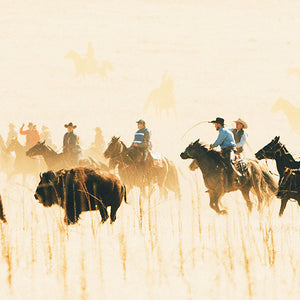This is part of our ROAM series, which charts the progress of our recently acquired ranch in the Texas Hill Country. Read the first piece here and the second here.
As the Central Texas trees turn from green to red and yellow to brown before shedding their leaves and grasses slowly transition into a winter dormancy, one thing is clear: fall has officially arrived at ROAM Ranch. But while fields frost and woodland creatures prepare for hibernation, our land is actually set to receive an injection of life from our first herd of bison. It has been an amazingly successful first six months here, a recovery period that has included the completion of our first phase of fence building, the construction of animal working systems, and the “resting” of our pastures. Although it’s still far from optimized, ROAM now has an abundance of grass thanks to a wet spring and summer. We’re starting to see traces of biodiversity return to the ecosystem.

Fall also marks the time of year when herds of bison across the country are rounded up, inspected, sorted, and sold. This timing is intentional — it’s when bison calves are beginning to reach maturity and their mothers are a little less protective. It’s a lot easier to round bison up when their mothers aren’t feeling stressed or threatened. These roundups also provide an opportunity for herd managers to make decisions on herd size and composition: the age-old battle of finding balance in a herd size that enriches the land vs. degrades it. Luckily, ranchers have this down to a science.
No broad measurement system is perfect when animals and land are involved, though. That’s why, while the county average and recommended stocking density for our area is one animal for every 25 acres, we are planning to run one animal for every 14 acres of land (totaling a herd of about 67 yearling bison) on ROAM this year. This decision stems from our estimate that this is the perfect amount of animal impact to catalyze a rapid, positive change in the ranch’s ecosystem. Though abnormal for the area, we will support almost twice as many animals as our neighbors thanks to our Savory Institute-inspired grazing plan, which follows a blueprint the environmental restoration group is using to heal grasslands across the world. Our plan is simple: mimic the natural herding and migratory instincts of the bison in a way that honors how these animals have co-evolved with our nation’s grasslands for thousands of years. That may sound grandiose, but it just means constantly rotating high-density herds of animals through different areas of the ranch. The key here is we’re taking into consideration the specific areas and timing in which the herds graze, so as to ensure grasses and other unique ecological characteristics are given ample time to heal and grow back stronger. The end result will be a healthier, more vibrant ecosystem strengthened by properly managed animal impact.

We couldn’t be more excited to get started with our bison. In fact, we have already contracted to purchase around 30 heifers (females) from The Nature Conservancy’s Tallgrass Prairie Preserve in Northern Oklahoma. This incredible 40,000-acre property is the largest protected example of tallgrass prairie ecosystem in all of North America. The preserve currently serves as home to roughly 2,700 bison, all of whom roam freely across most of the property without any human interference (apart from an annual roundup). Each year, the herd produces around 700 calves and, in order to maintain the appropriate balance of animal impact to available forage, The Nature Conservancy sells a carefully calculated amount of bulls, cows, and yearlings in a sealed bid process open to the public. Thankfully, our bids this year bought us this herd!
The Nature Conservancy has proven to be an incredible resource for us. Their ultimate goal — encouraging balanced animal impact while helping grow America’s bison population — resonates deeply with our values at EPIC. After all, we are both dedicated to restoring the tallgrass prairie ecosystem that flourished prior to westward expansion and colonization. The bison, of course, were the region’s primary historic grazer and the architects of the grasslands. It’s no coincidence their natural diet consists of about 99% grass, which dwarfs that of cattle (80%) and most sheep and goats (less than 50%). Bison were made to graze on prairies, making them the obvious tools to revitalize our ranchland.

Needless to say, we’re stoked to finally have our herds at ROAM. Their ability to act as carbon farmers and land stewards, paired with our careful implementation of key holistic management strategies, have us on the brink of turning a major corner in our journey to repair a once-decrepit plot of land. Thanks to the much-needed ecological reset we anticipate they’ll provide, we’re more optimistic than ever that next year will bring forth the sea of wildflowers once described by early explorers in the area.
Onwards to prosperity and positive animal impact, wolfpack! Plenty more to come soon.



